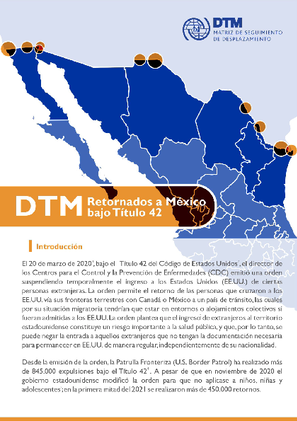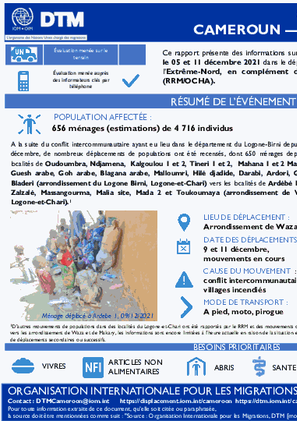-
Countries
-
Data and Analysis
-
Special Focus
-
Crisis Responses

Contact
DTM Guinée, oimguineedtm@iom.int
Language
French
Location
Guinea
Period Covered
Nov 01 2021
Nov 30 2021
Activity
- Flow Monitoring
Le suivi des flux de population (Flow Monitoring, FM) est un exercice qui vise à identifier les zones de forte mobilité interne et transfrontalière à fin de mieux comprendre les caractéristiques des flux migratoires.
Ce rapport présente les données obtenues pendant le mois de Novembre 2021 au niveau des FMPs de Boundou-fourdou dans la préfecture de Koundara au Nord du pays et de Kourémale dans la préfecture de Siguiri au Nord-Est de la Guinée. Ces données sont collectées lors de l’enregistrement des flux effectués auprès des voyageurs.

Contact
DTMMozambique@iom.int
Language
English
Location
Mozambique
Period Covered
Dec 08 2021
Dec 14 2021
Activity
- Event Tracking
- Mobility Tracking
During the reporting period (08 to 14 December 2021), a total of 38 movements were recorded - 16 arrivals (311 individuals),10 transits (311bindividuals), 8 departures (49 individuals), and 4 intended return movements (134 individuals). The largest individual arrivals were recorded in Ancuabe (75 individuals) and Nangade (53 individuals). The largest intended return movements were observed in Montepuez (51 individuals and 32 individuals). The largest transits were recorded in Montepuez (162 individuals and 139 individuals, with both groups leaving different areas of Montepuez, and transiting through Montepuez sede, in order to travel to Palma). Of the total population (37%) were displaced for the first time, and 63 per cent of reported IDPs had been displaced more than once prior to this latest movement.

Contact
iommexico@iom.int
Language
Spanish
Location
Mexico
Period Covered
May 03 2020
Jun 04 2020
Activity
- Community Perception
- Mobility Tracking
El 20 de marzo de 2020, bajo el Titulo 42 del Código de Estados Unidos, el director de los Centros para el Control y la Prevención de Enfermedades (CDC) emitio una orden suspendiendo temporalmente el ingreso a lost Estados Unidos (EE.UU.) de ciertas personas extranjeras. La orden permite el retorno de las personas que cruzaron a los EE.UU. vía sus fronteras terrestres con Canadá o México a un país de tránsito, las cuales por su situación migratoria tendrían que estar en entornos o alojamientos colectivos si fueran admitidas a los EE.UU. de manera regular, independiente de su nacionalidad.
Desde la emisión de la orden, la Patrulla Fronteriza (U.S. Border Patrol) ha realizado más de 845.000 expulsiones bajo el Título 42. A pesar de que en noviembre de 2020 el gobierno estadounidense modificó la orden para que no aplicase a niños, niñas y adolescentes; en la primera mitad del 2021 se realizaron más de 450.000 retornos.

Contact
DTM Nigeria, AllUsersInDTMNigeria@iom.int
Language
English
Location
Nigeria
Period Covered
Dec 06 2021
Dec 12 2021
Activity
- Event Tracking
- Mobility Tracking
Between 06 and 12 December 2021, a total of 10,978 movements were recorded in the states of Adamawa and Borno. The recorded movements consisted of 10,358 arrivals and 620 departures. Arrivals were recorded at locations in Askira/Uba, Bama, Biu, Damboa, Gwoza, Hawul, Monguno and Ngala Local Government Areas (LGAs) of the most conflict-affected state of Borno and in Fufore, Girei, Gombi, Hong, Lamurde, Maiha, Michika, Mubi South, Song, Yola North and Yola South LGAs of Adamawa.
Departures were recorded in Askira/Uba, Bama and Kala/Balge LGAs of Borno, and Gombi, Hong, Lamurde, Maiha, Michika, Mubi South, Numan, Song, Yola North and Yola South LGAs of Adamawa.
ETT assessments identified the following movement triggers: camp closure / government-assisted relocation in Bakasi Camp, Jere LGA of Borno State (7,785 individuals or 71%), voluntary relocation (1,493 individuals or 14%), poor living conditions (772 individuals or 7%), improved security (333 individuals or 3%), seasonal farming (281 individuals or 2%), conflicts/attacks (205 individuals or 2%) and fear of attacks (109 individuals or 1%).
IOM works with national and local authorities in order to gain a better understanding of population movements throughout Southern Africa. Through the setup of Flow Monitoring Points (FMPs), IOM seeks to quantify migration flows, trends and routes and to gain a better understanding of the profiles of observed individuals at entry, transit or exit points (such as border crossing posts, bus stations, rest areas, police checkpoints and reception centres). This report is an overview of the data collected in these FMPs from 1 to 30 November 2021.
Inter-regional migration from and within the Southern Africa is categorized along the following corridors. The Flow Monitoring Points (FMPs) were set-up in several key transit locations along the corridors to track the movements of passengers:
•Zimbabwe (Mutare) – Mozambique (Manica)
•Zimbabwe – Zambia (Chirundu)
•Zimbabwe – Botswana (Plumtree)
•Zimbabwe (Beitbridge) – South Africa
•Malawi (Mchinji) – Zambia (Mwami)
•Malawi (Karonga) – Tanzania
•Malawi (Mwanza) – Mozambique (Zobue)
During November 2021, a total of 87,422 movements were observed across 43 FMPs in the region.
The Zimbabwe (Beitbridge) – South Africa corridor hosted the largest number of movements with 59,124 (68%) followed by the Mozambique Malawi corridor with 16,792 (19%) and the Malawi – Zambia corridor with 5,021 movements reported (6%).

Contact
DTM Cameroon, DTMCameroun@iom.int
Language
French
Location
Cameroon
Period Covered
Dec 05 2021
Dec 11 2021
Activity
- Event Tracking
- Mobility Tracking
Ce rapport présente des informations sur le mouvements de populations enregistre entre le 05 et 11 décembre 2021 dans le département du Logone-Et-Chari de la région de l’Extrême-Nord, en complément des alertes d’autres acteurs humanitaires (RRM/OCHA). A la suite du conflit intercommunautaire ayant eu lieu dans le département du Logone-Birni depuis le 5 décembre, de nombreux déplacements de populations ont été recensés, dont 650 ménages depuis les localités de Oudoumbra, Ndjamena, Kalgoulou 1 et 2, Tineri 1 et 2, Mahana 1 et 2 Mardiya, Guesh arabe, Goh arabe, Blagana arabe, Malloumri, Hilé djadide, Darabi, Ardori, Galam Bladeri (arrondissement du Logone Birni, Logone-et-Chari) vers les localités de Ardébé 1 et 2, Zalzalé, Massangourma, Malia site, Mada 2 et Toukoumaya (arrondissement de Waza, Logone-et-Chari).

Contact
DTM Nigeria, AllUsersInDTMNigeria@iom.int
Language
English
Location
Nigeria
Period Covered
Dec 04 2021
Dec 10 2021
Activity
- Mobility Tracking
- Baseline Assessment
- Points of Entry (PoE)
During the COVID-19 pandemic, IOM's Displacement Tracking Matrix (DTM), in collaboration with the World Health Organization (WHO), monitors the movements to and from Nigeria's Adamawa and Borno States in North-East Nigeria. Assessments are conducted at Points of Entry located along the border with Cameroon.
During the period 04 - 10 December 2021, 192 movements were observed at three Points of Entry in Borno state. Of the total movements recorded, 151 were incoming from the Far North Region in Cameroon while 41 outgoing movements were recorded from Borno State to the Far North Region in Cameroon.

Contact
DTM Nigeria, AllUsersInDTMNigeria@iom.int
Language
English
Location
Nigeria
Period Covered
Dec 06 2021
Dec 12 2021
Activity
- Event Tracking
- Mobility Tracking
Nigeria's North Central and North West Zones are afflicted with a multidimensional crisis that is rooted in long-standing tensions between ethnic and religious groups and involves attacks by criminal groups and banditry/hirabah (such as kidnapping and grand larceny along major highways). The crisis has accelerated during the past years because of the intensification of attacks and
has resulted in widespread displacement across the region.
Between 06 and 12 December 2021, armed clashes between herdsmen and farmers; and bandits and local communities have led to new waves of population displacement. Following these events, rapid assessments were conducted by DTM (Displacement Tracking Matrix) field staff with the purpose of informing the humanitarian community and government partners, and enable targeted response. Flash reports utilise direct observation and a broad network of key informants to gather representative data and collect information on the number, profile and immediate needs of affected populations.

Contact
DTM DRC, iomdrcdtm@iom.int
Language
French
Location
Democratic Republic of the Congo
Period Covered
Nov 25 2021
Nov 26 2021
Activity
- Event Tracking
- Mobility Tracking
Du 13 au 21 novembre 2021, une série d’incursions attribuées aux miliciens CODECO a été rapportée dans les villages de Largu, Ngazba, Nyali, Kiza, Djisso, Djala, Jissa, Duma, Ngbaluba dans le groupement de Buku, chefferie de Bahema Nord, dans le territoire de Djugu et dans deux sites de déplacement, notamment le site Drodo situé dans le village de Duma, et le site de Tche dans le village de Dhessa, tous deux dans le groupement de Lossandrema, chefferie de Bahema Nord. Ces attaques ont causé d’importants dégâts matériels et humains : plusieurs maisons et abris ont été incendiés et détruits et plusieurs personnes déplacées ont été tuées ou blessées. Ces exactions ont obligé environ 80 000 individus à fuir leur village et site de déplacement pour trouver refuge dans le site de déplacement de Rhoe, en groupement Buku, chefferie de Bahema Nord, dans le territoire de Djugu en province d’Ituri. Les villages et site de déplacement qui ont été attaqués sont aujourd’huividés de leur population.

Contact
DTM Sudan; dtmsudan@iom.int
Language
English
Location
Sudan
Snapshot Date
Dec 12 2021
Activity
- Event Tracking
- Mobility Tracking
The DTM Emergency Event Tracking (EET) is deployed to track sudden displacement and population movements, provide more frequent updates on the scale of displacement, and quantify the affected population when needed. As a subcomponent of the new Mobility Tracking methodology in Sudan (Round Two), and activated on a need basis, EET utilises a broad network of key informants to capture best estimates of the affected population presence per location – a useful tool for humanitarian response planning and design.
